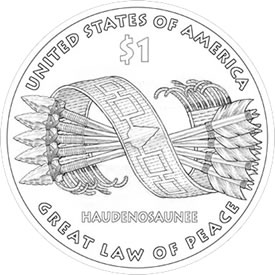"Government – The Great Tree of Peace" has been announced as the theme for the 2010 Native American $1 coin by the US Mint. The coins will be issued beginning in January and throughout the year to meet demand.
As dictated by the Native American $1 Coin Act (Public Law 110-82), the reverse of these coins feature a different reverse design annually that contain "images celebrating the important contributions made by Indian tribes and individual Native Americans to the development of the United States and the history of the United States."
The 2010 design shows a Hiawatha Belt with five arrows bound together. The belt signifies the creation of the Haudenosaunee, also known as the Iroquois Confederacy.
In the center of the belt is a white pine that symbolizes the Onondaga Nation with the remaining four characters signifying the other nations that were part of the Confederacy, the Mohawk, Oneida, Cayuga and Seneca.
Designed by Artistic Infusion Program Master Designer Thomas Cleveland, the bundle of arrows show the strength in unity of the five participating nations.
Surrounding the belt and arrows are the inscriptions "UNITED STATES OF AMERICA," "GREAT LAW OF PEACE" "HAUDENOSAUNEE" and "$1."
The Iroquois Confederacy was founded sometime around the 16th century and was based in the area around present-day New York. It was a loosely based political structure that united the local tribes.
Sacagawea is featured on the obverse of all the Native American coins. The design was first seen on the 2000 Sacagawea golden dollar and shows the famous Shoshone woman (with a child on her back) who accompanied explorers Lewis and Clark on their expedition through the frontiers of America. The inscriptions "LIBERTY" and "IN GOD WE TRUST" are also seen.
Struck from copper covered in manganese brass creating a golden color, the coins also feature the edge inscribed lettering showing the year of mint, "E PLURIBUS UNUM" and the mintmark.
Presidential dollar coins are also struck during the same time frame as the Native American Dollars, but legislation requires that at least 20% of all the dollars minted must be Native American. When the Presidential dollars end around 2016, the Native American coins are still to be struck featuring new designs as determined by the Secretary of the Treasury with input from other parties.
The 2009 design of the Native American $1 depicts a Native American woman planting seeds in a field of corn, beans and squash. The scene represents the Three Sisters method of planting.







Looks nice
Satisfying to see recognition of First Nations in your Coin Acts. There are many contributions and cultural traditions which will help to educate the general public and may contribute to a better understanding and interest in First Nations history.
Sorry to say I don’t believe there is anything comparable in Canadian legislation.
RESPECTFULLY Just who do you think that you are fooling ? The general public has to go to E Bay to obtain The First NA Dollar coin and NOT at one for one. This is a clear violation of the INTENT, public law and the NA Coin Act. Also, the US Banks say that they can not even order the NA Coins like they do the Presidential Dollar Coins. If the PUBLIC that uses the coins for CIRCULATION can not obtain the coins on a one for one basis one has to be retarded to think that these coins are… Read more »
Hawksley you are sadly mistake. I just went to my local bank and found it very easy to get the NA dollar each teller had at least one roll that they could give out on a one to one ration so I think you should do some research before you start bashing our gov’t.
I got one of these gold coins on the ground and I found a 2011 Olympic coin:-)